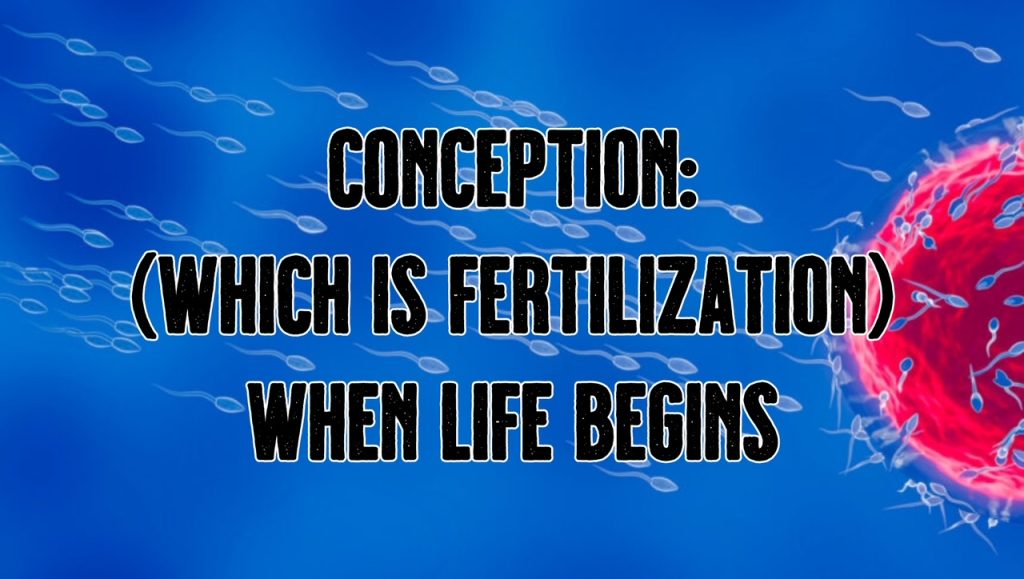We know that life begins at conception – which is fertilization. But perhaps you, dear reader, have questions about the science behind this. Or perhaps, like us, you have encountered people who both deny science entirely and do not care about the consequences of their actions, as well as people who have a genuine curiosity regarding the science behind when life begins. Below are a few sources we have compiled that will hopefully be helpful when needed in certain conversations.
But before we get to that there are two vital things to note and keep in mind whenever researching issues around the beginning of life (such as when life begins, hormonal birth control, or In Vitro Fertilization) that involve proper definitions.
- First: In the 1960s the medical world began to obfuscate the words “fertilization” and “conception.” These two words historically meant the same thing: when life begins. Now, however, and since the 60s, the word “conception” which is the biblical word for when life begins, is being used as a synonym for “implantation” – which is when a newly created human embryo successfully attaches himself/herself to the endometrium (the inner lining of the uterus) usually taking place 7-10 days after fertilization.
- Secondly: “Pregnancy” is medically defined as starting at implantation, which again, as explained in the paragraph above, takes place days after fertilization, after the baby’s life has already begun. So by this definition, though a human life begins at fertilization, pregnancy *according to medical terminology* does not begin until days later.
This obfuscation and definition of words is a clever deception and it is vital to know when having conversations with people who may not know, or who may defend an abortifacient mechanism that is marketed as not having any “post-conception effect.” So in conversations about the beginning of life, when using the word “conception,” adding “which is fertilization” is something that I would personally recommend.
And now, here is that list of sources. Thanks for reading!
- “Human life begins at fertilization, the process during which a male gamete or sperm (spermatozoo development) unites with a female gamete or oocyte (ovum) to form a single cell called a zygote. This highly specialized, totipotent cell marked the beginning of each of us as a unique individual.” “A zygote is the beginning of a new human being (i.e., an embryo).” – Keith L. Moore BA MSc PhD DSc FIAC FRSM FAAA, The Developing Human: Clinically Oriented Embryology, 7th edition. Philadelphia, PA: Saunders, 2003. pp. 16, 2.
- “Human development begins after the union of male and female gametes or germ cells during a process known as fertilization (conception). “Fertilization is a sequence of events that begins with the contact of a sperm (spermatozoon) with a secondary oocyte (ovum) and ends with the fusion of their pronuclei (the haploid nuclei of the sperm and ovum) and the mingling of their chromosomes to form a new cell. This fertilized ovum, known as a zygote, is a large diploid cell that is the beginning, or primordium, of a human being.” – Moore, Keith L. Essentials of Human Embryology. Toronto: B.C. Decker Inc, 1988, p.2
- “The chromosomes of the oocyte and sperm are…respectively enclosed within female and male pronuclei. These pronuclei fuse with each other to produce the single, diploid, 2N nucleus of the fertilized zygote. This moment of zygote formation may be taken as the beginning or zero time point of embryonic development.” – Larsen, William J. Human Embryology. 2nd edition. New York: Churchill Livingstone, 1997, p. 17
- “The development of a human being begins with fertilization, a process by which two highly specialized cells, the spermatozoon from the male and the oocyte from the female, unite to give rise to a new organism, the zygote.” – Langman, Jan. Medical Embryology. 3rd edition. Baltimore: Williams and Wilkins, 1975, p. 3
- “Although life is a continuous process, fertilization is a critical landmark because, under ordinary circumstances, a new, genetically distinct human organism is thereby formed…. The combination of 23 chromosomes present in each pronucleus results in 46 chromosomes in the zygote. Thus the diploid number is restored and the embryonic genome is formed. The embryo now exists as a genetic unity.” – O’Rahilly, Ronan and Muller, Fabiola. Human Embryology & Teratology. 2nd edition. New York: Wiley-Liss, 1996, pp. 8, 29.
- “Every human embryologist in the world knows that the life of the new individual human being begins at fertilization. It is not belief. It is scientific fact.” C. Ward Kischer, Ph.D., Author, When Does Human Life Begin? The Final Answer, Human Embryologist, professor, University of Arizona College of Medicine.
- “In that fraction of a second when the chromosomes form pairs, the sex of the new child will be determined, hereditary characteristics received from each parent will be set, and a new life will have begun.” – Kaluger, G., and Kaluger, M., Human Development: The Span of Life, page 28-29, The C.V. Mosby Co., St. Louis, 1974.
- “It is the penetration of the ovum by a sperm and the resulting mingling of nuclear material each brings to the union that constitutes the initiation of the life of a new individual.” – Clark Edward and Corliss Patten’s Human Embryology, McGraw – Hill Inc., 30
- “The chromosomes of the oocyte and sperm are…respectively enclosed within female and male pronuclei. These pronuclei fuse with each other to produce the single, diploid, 2N nucleus of the fertilized zygote. This moment of zygote formation may be taken as the beginning or zero time point of embryonic development.” – Larsen, William J. Human Embryology. 2nd edition. New York: Churchill Livingstone, 1997, p. 17
- Development of the embryo begins at Stage 1 when a sperm fertilizes an oocyte and together they form a zygote.” – England, Marjorie A. Life Before Birth. 2nd ed. England: Mosby-Wolfe, 1996, p.31
- “Zygote: This cell, formed by the union of an ovum and a sperm (Gr. zyg tos, yoked together), represents the beginning of a human being. The common expression ‘fertilized ovum’ refers to the zygote.” – Keith L. Moore BA MSc PhD DSc FIAC FRSM FAAA, T.; V. N. Persaud MD PhD DSc FRCPath (Lond.); and Mark G. Torchia MSc PhD. Before We Are Born: Essentials of Embryology and Birth Defects. 4th edition. Philadelphia: W.B. Saunders Company, 1993, p. 1
- “Embryo: An organism in the earliest stage of development; in a man, from the time of conception to the end of the second month in the uterus.” – Dox, Ida G. et al. The Harper Collins Illustrated Medical Dictionary. New York: Harper Perennial, 1993, p. 146
- “Embryo: the developing organism from the time of fertilization until significant differentiation has occurred, when the organism becomes known as a fetus.” – Cloning Human Beings. Report and Recommendations of the National Bioethics Advisory Commission. Rockville, MD: GPO, 1997, Appendix-2.
- “In man the term ’embryo’ is usually restricted to the period of development from fertilization until the end of the eighth week of pregnancy.” – Walters, William and Singer, Peter (eds.). Test-Tube Babies. Melbourne: Oxford University Press, 1982, p. 160
- “Embryo: The developing individual between the union of the germ cells and the completion of the organs which characterize its body when it becomes a separate organism… At the moment the sperm cell of the human male meets the ovum of the female and the union results in a fertilized ovum (zygote), a new life has begun… The term embryo covers the several stages of early development from conception to the ninth or tenth week of life.” – Considine, Douglas M. (ed.). Van Nostrand’s Scientific Encyclopedia. 5th edition. New York: Van Nostrand Reinhold Company, 1976, p. 943
- “Almost all higher animals start their lives from a single cell, the fertilized ovum (zygote)… The time of fertilization represents the starting point in the life history, or ontogeny, of the individual.” – Carlson, Bruce M. Patten’s Foundations of Embryology. 6th edition. New York: McGraw-Hill, 1996, p. 3






